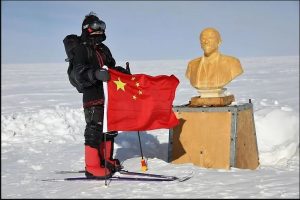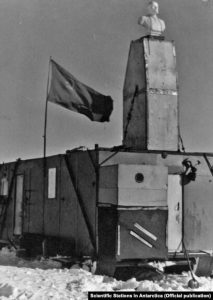 Chinese explorer and adventurer, Feng Jing, hiked to the Southern Pole of Inaccessibility (POI), which is the farthest point from all the coastlines of Antarctica.
Chinese explorer and adventurer, Feng Jing, hiked to the Southern Pole of Inaccessibility (POI), which is the farthest point from all the coastlines of Antarctica.
With two assistants she reached the POI after 80 days on January 25, 2020. It is a remarkable achievement traversing over 1,800 kilometers in extreme conditions; one fascinating aspect to the trip is that there is a Lenin statue at the Pole of Inaccessibility! No one had ever reached the spot on foot before and also, very few people have ever visited this inhospitable spot.
.
Have a look at the video below (start it at min 2:09)
Pole of Inaccessibility (aka Polyus Nedostupnosti Station)
In 1958 the Soviet Union sent an expedition of scientists there, with the goal of establishing a Base Camp at 82° 06’ South, 54°58’East. Equipment and personnel were delivered by an Antarctic tractor convoy operated by the 3rd Soviet Antarctic Expedition.  The station had a hut for four people, a radio shack, and an electrical hut. These buildings had been constructed on the tractors used during the traverse, serving as accommodation. On top of the camp structures, they placed the Lenin bust. Next to the hut, an airstrip was cleared and a Li-2 aircraft landed there on 18 December 1958. The outpost was equipped with a diesel power generator and a transmitter. Pole of Inaccessibility Station performed meteorological observations from 14 to 26 December 1958.
The station had a hut for four people, a radio shack, and an electrical hut. These buildings had been constructed on the tractors used during the traverse, serving as accommodation. On top of the camp structures, they placed the Lenin bust. Next to the hut, an airstrip was cleared and a Li-2 aircraft landed there on 18 December 1958. The outpost was equipped with a diesel power generator and a transmitter. Pole of Inaccessibility Station performed meteorological observations from 14 to 26 December 1958.
On 26 December the outpost was vacated indefinitely. Four researchers were airlifted out, and the remaining 14 members of the party returned with the tractors. The Station was deemed to be too far from other Research Stations to allow safe permanent operation, so it was left to be used for future short-term visits only. The Pole of Inaccessibility has the world’s coldest year-round average temperature of −58.2 °C (−72.8 °F).
The camp was essentially abandoned and only a handful of people have travelled there. The camp buildings were buried by snow over the last 60 years, but incredibly Lenin is still visible and there unharmed having survived despite it all.
Read more about Pole of Inaccessibility at: The Pole Or Bust! The Loneliest (And Coldest) Lenin (rferl.org)
 The 8th Soviet Antarctic Expedition visited the site on 1 February 1964 and left five days later.
The 8th Soviet Antarctic Expedition visited the site on 1 February 1964 and left five days later.
The American Queen Maud Land Traverse, reached the Pole of Inaccessibility from Amundsen-Scott South Pole Station (WAP USA-21) on 27 January 1965. The crew were flown out by a Lockheed C139 Hercukes on 1 February. On 15 December 1965 a new American crew arrived by C-130 to make observations, refurbish the snow cats, and continue the Queen Maud Land Traverse, zig-zagging to the newly installed Plateau Station (WAP USA-13) where they arrived on 29 January 1966.
The 12th Soviet Antarctic Expedition visited the site in 1967.
On 19 January 2007, the British Team N2i reached the Pole of Inaccessibility using specially-designed foil kites.
On 27 December 2011, during the Antarctica Legacy Crossing, Sebastian Copeland, and partner Eric McNair-Landry, reached the Pole of Inaccessibility by foot and kite ski from Novolazarevskaya Station (WAP RUS-Ø9), on their way to completing the first partial east–west transcontinental crossing of Antarctica of over 4,100 km (2,500 mi).
The station building is surmounted by a bust of Vladimir Lenin facing Moscow. It is almost entirely buried by snow, with little more than the bust visible.
Following a proposal by Russia to the Antarctic Treaty Consultative Meeting, the buried building and emergent bust, along with a plaque commemorating the conquest of the Pole of Inaccessibility by Soviet Antarctic explorers in 1958, has been designated a Historic Site or Monument (HSM 4).
Speaking as a Radioamateur, I must say that it is a real shame that, for some years in Antarctica, the Hamradio culture has no longer had the importance it once did.
That several expeditions, like these ones over the last 50 years to the Pole of Inaccessibility Station, were not accompanied by radio operators to give radio amateurs from all over the world the chance to contact a place so full of history, let me say, is truly a shame! Let’s hope that, before too long, a new expedition could operate HF from Pole of Inaccessibility Station (HSM#4)!
